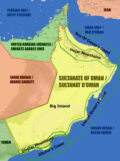What to do in Oman in July & August?
In the north, july and august are very hot : temperatures are higher inland (with peaks at 50°C) but the air is dry, which makes it more beareable than the 40°C with high humidity on the coast.
In Al Hajar mountains, from mid- end- july, there are often convection clouds developping around noon and sometimes sudden localized storms in the after-noon. It makes the weather a bit more bearable.
In the south, it’s “Khareef” season, that’s to say monsoon season : temperatures drop, strong rains alternate with covered sky and foggy days ; the landscape becomes green (pastures and woodland) and rivers appear making sometimes superb waterfalls! It’s the summer holiday spot for most Omanis from the north and other Gulf inhabitants.
In the north, it’s the heart of the date harvesting season.
Climate in July & August in Oman
Below is a summary of the weather in the main climate zones of Oman.
The markers 🟢🟡🟠🔴 show our opinon (subjective, but based on objective facts) regarding the possibilities for hiking and camping.

Climate Zones
Climate in July and August
Coast of the sea of Oman
🔴
Very hot temperatures (~40°C daytime / ~ 30°C nighttime)
High humidity
Strong sun
Coast of the Indian Ocean
(Ras Al Hadd > Shuwaymiyah)
🟡
Quite hot temperatures (~30-35°C daytime / ~ 20-25°C nighttime)
Medium humidity
Strong sun
Strong wind
Coast of the Indian Ocean
(Dhofar)
🟢
Nice temperatures (~25°C daytime / ~ 25°C nighttime)
High humidity (frequent rain and fog)
Sun covered by clouds
Mousson (Khareef)
Big Inland *
🔴
Very hot temperatures (~45°C daytime / ~30°C nighttime)
Low humidity
Strong sun
Hajar Mountains **
~1000m height
🔴
Very hot temperatures (~40-45°C daytime / ~ 25°C nighttime)
Low humidity
Strong sun
Often convection clouds in the afternoon and sometimes sudden localized storms
Hajar Mountains **
~2000m height
🟡
Hot temperatures (~30-35°C daytime / ~ 20°C nighttime)
Low humidity
Strong sun
Often convection clouds in the afternoon and sometimes sudden localized storms
Dhofar Mountains
~1000m height
🟢
Nice temperatures (~20°C daytime / ~ 15-20°C nighttime)
High humidity (frequent rain and fog)
Sun covered by clouds
Monsoon (Khareef)
* in the desert (above all Rub Al Khali, and to a lesser extent in Wahiba Sands), temperatures rise higher during the day, and drop lower at night (~5-10°C gap, sometimes more).
Bad weather in Northern Oman bring sudden drop in temperatures inland.
** in the montains, above all in winter (when the sun is lower), there can be big difference between northern slopes, which see less sun, and southern slopes which are continuously exposed. The same apply to steep-sided places.
Most suitable outdoor activities in Oman in July & August
According to us, in the north, the only possible (thus particularly pleasant) outdoor activity is aquatic hiking and canyoning (which we do without wetsuits, wearing shorts and t-shirts) : we spend the full day in the water while it’s more than 40°C outside!
However, one has to be careful because of possible sudden localized storms in the afternoon which might produce flash floods.
It’s still the high season for green turtles to lay eggs, whiich one can watch at the marine reserve of Ras Al Jinz. In summer, up to 200 turtles might come same night on the same beach to lay eggs!
Season for kitesurfing and windsurfing goes on (starting in May and finishing early September) on the coast of the Indian Ocean (between Ras Al Had and Shuwaymiyah).
In the Sea of Oman, summer is the best season for diving because of a better visibility.
Finaly, the coast and mountains of Dhofar, which receive monsoon rains (khareef) in July and August, are interesting to visit : beyond beautiful nature, it’s an interesting experience for a non-arab to see local summer holiday… rain, fog, coconuts, bananas, rivers and waterfalls, endemic flora, beautiful beaches, rugged ocean, and … grilling meat!!!






Outdoor activities to avoid in Oman in July and August
In Northern Oman, it’s too hot for mountain hiking, camping in the lowlands (even higher in the mountains, we can’t really say it’s fresh…), spending a full day at the beach, and obviously for going in the desert…
In Southern Oman (Dhofar), it’s too slipery (humidity + clay = mud) for hiking : in the rainy season, even the cattle (camels and cows) stays at the foot of the mountains, in the valleys and on the coast, because the breeders are afraid they slip and fall in steep ravines…
Do you plan to travel to Oman in July or August?
We do not schedule group trips, which you could join during these months.
However, we can organise on-demand tailor-made private tour in Northern Oman including canyoning and aquatic hiking, maybe also turtle watching and half-day snorkeling .
Also, if you wish to visit Dhoofar during Khareef season, we can organise this for you, … a local way! (this kind of tour is not advertsied on our website…)
Contact us by email or by whatsapp
We do not offer diving, nor kitesurfing…


